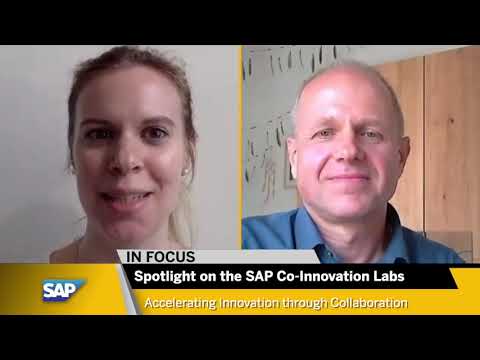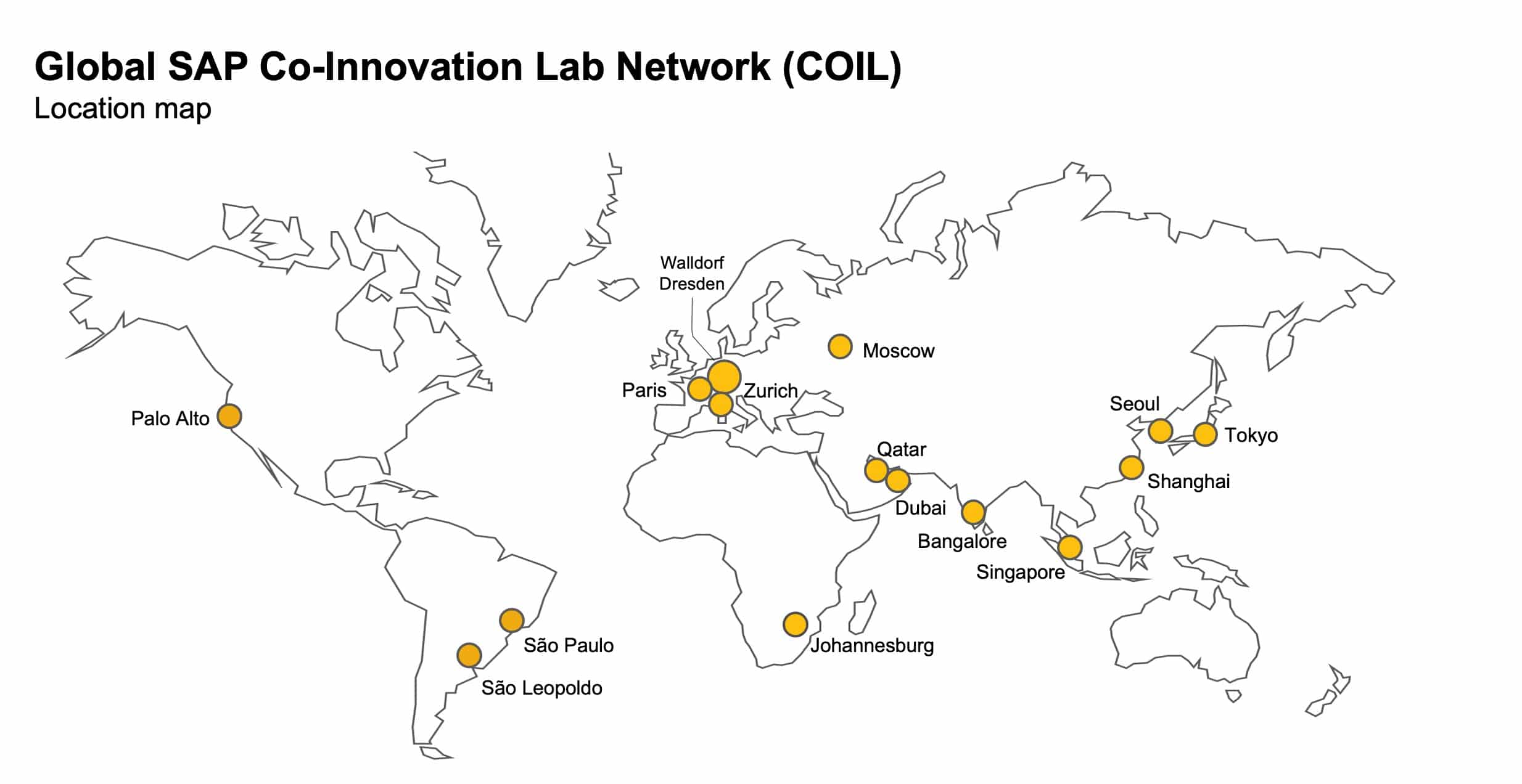What do milk consumers from Germany, sugar cane harvesters from Royal Swaziland, and truck drivers on the streets of Moscow have in common?
“They are the end users three of our co-innovation projects were aimed at,” says Rudi Held, global head of SAP Co-Innovation Lab, a developer network spanning 16 locations worldwide. The network works with its global ecosystem of customers, partners, and startups to develop solutions that make people’s lives a little bit easier.
These solutions are three examples of more than 1,000 co-innovation projects that SAP Co-Innovation Lab completed successfully over the last 13 years. “Co-innovation is a part of our DNA here at SAP,” says Held. “It’s been one of the foundations for SAP’s success. With the launch of the network, we took it to the next level.”

There are various departments at SAP that focus on co-innovation and help the Walldorf software giant stay ahead of the game. But SAP Co-Innovation Lab’s approach is unique. In each of its co-innovation projects, a partner, a customer, and experts from SAP are involved.
Enabling Partners, Answering Customers’ Business Needs
“We facilitate and support co-innovation between SAP and its ecosystem of startups, SAP partners, future partners, and customers. Co-innovation opens a world of possibilities,” Held says. “What counts is making the most of an idea – together. Technological change has become so rapid and today’s tech scene is so diverse and specialized that it would be neglectful not to join forces to bring the greatest possible value to a customer.”

Founding SAP Co-Innovation Lab in 2007 was a strategic decision. “At SAP, we realized that a strong ecosystem can create value for customers by providing complementary solutions and adding functional gaps for SAP products,” says Kevin Qin, head of SAP Co-Innovation Lab in Shanghai.
Lucas Rigo, solution specialist from Brazil, explains, “Some solutions might not be feasible or profitable for SAP, but for our partner ecosystem they are. That’s why it is so important to keep a trustful relationship with our partners.”
The emotional side of working with customers and partners is also important, says Vidya Gugnani, program director at SAP Co-Innovation Lab in Dubai. “Working with our partners and customers we want to find the best way to enhance the way they work and come up with agile solutions. To connect with them on an emotional, technical, and practical level, we make strong use of design thinking, ideation, and prototyping sessions to help us generate ideal outputs.”
This mindset also shows in the way collaboration takes place. And its engagement model offers developers the chance to work in complementary teams with employees from other SAP units, the customer, and the partner.
“Everyone brings their specific technical expertise, and we are all smarter after the project than we were when we started it,” says Joey Bronner, senior software engineer with SAP Co-Innovation Lab in Paris. “For me, as a software engineer, SAP Co-Innovation Lab is a dream-come-true working environment. We get to play with the latest technologies and solutions and build innovative prototypes, all while constantly improving our own skills as well as the partner’s.”
Wael Labidi, technology innovation architect also from SAP Co-Innovation Lab in Paris, points out the need to tackle global problems on a global scale: “Innovation today differs from models adopted in the past that focused mainly on profit and targeted one specific society at a time. Looking ahead to future societies, it is crucial to foster innovative solutions that generate social and public value.”
Co-Innovation: Integral Part of Intelligent Enterprise Survival Kit
“Gaining a common understanding of what the partner can and would like to do [and] how this can then be technically implemented with our products,” is the greatest daily challenge, says Pascal Hagedorn, co-innovation architect at SAP Co-Innovation Lab in Zurich. “Expectations, technologies, and requirements change in every project. But if it’s done right, customers receive what was promised by the partner – plus the integrated and extended added value of their SAP installations.
“Change is no longer a choice as we are in the middle of the fourth industrial revolution, which has a scale and complexity like nothing we have experienced before,” says Labidi. “I see what SAP Co-Innovation Lab is doing – sharing knowledge, collaborative thinking, and complex system prototyping – as a key part of the Intelligent Enterprise survival kit.”
All of this makes SAP Co-Innovation Lab an attractive and well-known entry point for partners, according to Rigo. “It is the best way a partner can start an engagement with SAP – whether they are new to the SAP ecosystem or an existing partner exploring a new solution.”
For customers who want to do proof of concept or pilot projects using SAP products with low initial investment and risk, SAP Co-Innovation Lab is an excellent option as well, says Dong Woo Lee, head of the lab location in Seoul. “SAP Co-Innovation Lab provides partners and customers not only with technical support but also with business advice. In a company as large as SAP, it can be challenging to find the right contact person. The lab gives partners and customers access to its network of product and solution experts.”
Continuous Learning and Diversity: Recipe for Success
As SAP Co-Innovation Lab employees cannot be experts in each and every SAP product, they constantly need to bring their knowledge up to date effectively and quickly.
“I’m relatively new,” says Phillip Phiri, innovation engineer at SAP Co-Innovation Lab in Johannesburg. “But what I noticed right from the beginning is that I have to continuously keep learning about new technologies that SAP partners might want to use in a co-innovation project. And I often have to revise my understanding of technologies I’m already familiar with.”
While this is challenging for the SAP Co-Innovation Lab developers, it adds to the speed at which their co-innovation projects are executed. “As we all stay up to date with the latest technological advancements, this helps us to deliver solutions quickly,” Phiri adds. “For our customers, this reduces the risk of partnering with SAP. They get to build a solution quickly and affordably before attempting to tackle the rest of the partnering journey.”
Itumeleng Mashifane, data scientist at SAP Co-Innovation Lab in Johannesburg, says, “Within the network, there is this enormous sense of collaboration. Different ideas are exchanged in a global team of experts in diverse fields. Customers can rest assured that the team effort in every project is steered towards achieving customer success.”
“I love how at SAP Co-Innovation Lab we are never serving just one line of business or working with just one kind of technology,” says Ami Tharayil, co-innovation intern at the lab location in Dubai. “Instead, we get to use the most innovative technology in every challenge brought to us and help the customer evolve in their own business.”
She considers diversity one of the network’s most important assets. “All my colleagues come from different parts of the globe. So do our customers and partners. That is essential to how ideas are shared, developed, and innovated upon.”
To Phiri, diversity plays an integral role in his daily work as well. “I think SAP Co-Innovation Lab might be one of the most diverse teams within SAP,” he says. “I’m a Black person from South Africa, and I get to work with colleagues from various other backgrounds – Indian, Chinese, Japanese, Korean, Latinx, European. Not only is everybody made welcome and fostered in the same way, we make this diversity part of our strength.”
Held emphasizes the need to have a diverse team in order to develop solutions that will improve the lives of different people in different countries. “It broadens everybody’s horizons, leads to a better understanding of the world and the potential users of our solutions. To me, the fact that we have 50 brilliant people in SAP Co-Innovation Lab – from different countries and backgrounds with different genders and different expertise – is the key to our success.”



